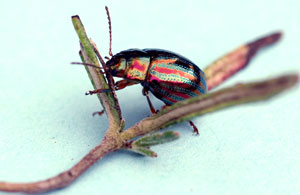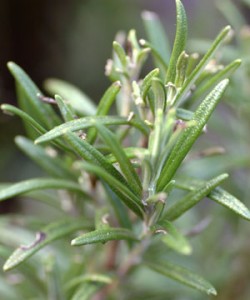The Rosemary Beetle
In recent years, there has been a new entrant to the RHS list of top ten garden pests. Its ‘top ten’ list is based on the number of inquiries that it receives to its advisory service. The newcomer is the rosemary beetle, Chrysolina americana. Despite the implication, from its scientific name, that it is American in origin, it actually hails from Southern Europe.This beetle has now become established in the London and the Home Counties, Norwich and a number of other places - map available here.
The adult beetle is about 8mm in length, and is a metallic green colour with purple stripes. Its larvae or grubs are greyish white with darker lines running along the body. The life cycle of the beetle is under study at the entomology laboratory at Wisley.
Initial observations suggest that adult beetles are relatively inactive on the host plants in June through to August, but that they begin feeding again in late August and September.  During this time, they mate and lay their eggs on the underside of leaves (these are about 2mm in length and sausage shaped). They continue to mate on warm winter days through to the Spring. When the eggs hatch, the larvae feed on the leaves for about three weeks and then enter the soil to pupate. This stage of internal reorganisation lasts about two to three weeks and then the adults emerge, returning to the host plants. Where the beetles / larvae feed on a leaf, it may turn a brown grey colour where tissue is damaged; the leaves may be reduced down to shortened stumps.
During this time, they mate and lay their eggs on the underside of leaves (these are about 2mm in length and sausage shaped). They continue to mate on warm winter days through to the Spring. When the eggs hatch, the larvae feed on the leaves for about three weeks and then enter the soil to pupate. This stage of internal reorganisation lasts about two to three weeks and then the adults emerge, returning to the host plants. Where the beetles / larvae feed on a leaf, it may turn a brown grey colour where tissue is damaged; the leaves may be reduced down to shortened stumps.
The beetle is recognised as a pest mainly on Rosemary (Rosmarinus officinalis) and Lavender (Lavandula sp). However, it can also use Thyme (Thymus sp) and Sage (Salvia sp) as a host and there is a concern that it may be able to use other plants of the Lamiaceae (Labiate) family.  The beetle can be controlled by ‘hand picking’ of the beetles and grubs from the plants (or by using insecticides). However, bearing in mind that these plants are favoured by bees then pesticides should not really be used when the plants are in flower. As the beetles tend to be active in late summer / early autumn, then this might be a better time to apply insecticide.
The beetle can be controlled by ‘hand picking’ of the beetles and grubs from the plants (or by using insecticides). However, bearing in mind that these plants are favoured by bees then pesticides should not really be used when the plants are in flower. As the beetles tend to be active in late summer / early autumn, then this might be a better time to apply insecticide.
To report a sighting of the beetle to the RHS, you can use this link (opens a new page)
Further work on the rosemary beetle is being carried out at the John Innes Centre at Norwich by Dr Ian Bedford
Comments are closed for this post.
Discussion
I’ve never seen these on my rosemary bush before. Only until now this March 2017. My kids are so fascinated by the colours it has. We had to Google it to find out what they are. Until we came across your site now we no. I’m in Hemel Hempstead Hertfordshire.
Hello,
We found several rosemary leaf beetles (Chrysolina americana) in our garden today (Oct. 29 2016)- Newcastle upon Tyne. We do have lavender near where they were; they seemed to like being on sedum flowers.
Found one on my lavender this afternoon in luton (LU4 0LE)
23 July 2016
Only one of my 6 Rosemary plants round the garden is suffering, whole plant is turning yellow. Picked [& squashed] 30 plus beetles one day, 18 the next and 6 pint sized today. Also cut out the cuckoo spit daily as I figured it may be covering their eggs. First year we have had them here [Surrey GU72QH] and also in London where they have decimated one Rosemary and 3 Lavender bushes, all died. Watching Lavender hedge with apprehension. 17/6/16.
This is the first year I have ever seen Rosemary beetle and I have worked closely with Rosemary and Lavender for many years in the UK. Hand picking them is relatively easy and dropping them in a jar of soapy water is as humane a death as you can hope for. Please do not resort to chemical control you will do more harm to beneficial insects and bees. Collecting these beetles on a Sunny day is easier as the metallic shine reflects the bright sun making them easier to find. To help you identify this beetle I have posted some photographs of the Rosemary beetle on my gardening blog page. I’m in St Albans, Hertfordshire.
I have seen them on my rosemary, lavender and sage. They are very pretty, sadly. I also have always left them alone because beetles are usually beneficial and since these look like metallic ladybirds I thought they must be good for the plant. I’m actually going to have trouble killing them because I’ve thought they were ‘goodies’ for years. The birds must be feasting on them because my plants are all lush and happy even though I’ve left them alone. Maybe having a bird feeder might help everyone with decimated plants. I’m in Cardiff.
Found one on our Rosemary 3 rd April, 2016 : Leeds, UK
Just went to get some rosemary for the Easter roast lamb, and discovered the bushes had all been nibbled! Cut some and soaked it in water and found what turned out to be two of the larvae. Went on a bug hunt, and found one very large mature beetle and about 6 more grubs. Will try the soap spray mentioned above, as well as weekly picking. I’m in Milton Keynes, Buckinghamshire.
Found one on what was left of my mint today (I was pulling it up). I have no rosemary or lavender in my garden. Outskirts of Ipswich, Suffolk.
I found dozens of these little blighters on my lavender and rosemary I have been picking them of and spraying with liquid soap they don,t seem to like it only found on or two this week but got my eye out for them daily. Apparntly the lavae could be a bigger problem. (Huddersfield)
We have them now in our new lavenders. since I don’t want to lose the young hedge or any pollinators, I am picking off the adult beetles and putting them in the freezer to kill them. Guess dealing with the grubs will be a little harder. (Dothan)
my daughter lives in Weybridge, Surrey and they have found these beetles on their rosemary bush.
On our lavender hedge in my back garden in lowesoft, suffolk
That is what is suggested above – noting that pesticides would damage bees / pollinators etc.
Good grief, are pesticides the answer to everything? Just pick them off and monitor the plants regularly. Job done and no risk to the beneficial insects.
I have these on my rosemary bush here in Jersey, if it is of interest to you. They are stunning in the sunshine!
On a lavender bush in Rochester, Kent
I had well established Rosemary and Lavender bushes in my front garden in Liverpool. Suddenly in 2013 ‘something happened’ and both were decimated. Cause was established as ‘cute’ little stripped beetles.
War has been declared. I am currently searching for a pesticide to treat the ground.
We have found lots of these beetles on our lavender in Melbourn, Cambridgeshire. Jess Aged 7.
We planted approx 10m of lavender hedge 15 years ago. 3 years ago, as a mature and beautiful hedge we discovered the beetle infesting it. We picked approximately 100 beetles off and have carefully watched ever since. We haven’t eradicated them but now only find 3-5 a week or even less. I shall watch carefully in the autumn. THANKS FOR THE TIPS! Does John Innes Centre still want more?
CB Ware, Herts
We have the beetle in huyton nr liverpool post code l367sr
These beetles seem to hide at the junction of branches. When disturbed they always fall on their backs,so presenting black-side-up,which makes them harder to find! They hate liquid soap spray,which makes them drop to the ground (or plastic sheet). The giveaway is the curved cuts to the leaf ends, which then go black.
It’s good to view the bush at different angles in order to ensure all have been spotted. Our bush is now free of them!
We have a Rosemary hedge that is infested with these beetles, I will try to remove them witha ready mixed spray in September / October.
Yuck, we dont have these in the midwest part of the US. I wonder if it is because of the climate?

Found in Senghenydd, Caerphilly,Wales UK
Welsh sweet pea
21 April, 2017